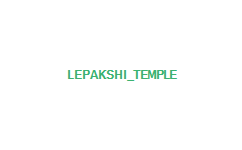Thank you very much to all for your valuable encouragement. In this blog i am trying to explore Indian Heritage and Culture in various aspects by using the images from my own collection and also from other people collection with their kind permission. If any person or organization think that some of the images which i am using in my blog are relating to their own property and copyright then i request them to intimate me and i remove them immediately from my blog.
About Me

- dokka srinivasu
- I am collecting Indian Heritage and culture related vintage postcards, paintings, prints etc. and exhibited them at several locations across India in various events and also sharing them with school and college children by giving presentations to them on Indian Heritage and Culture with my collections and also documenting puppetry etc. intangible performances.
Saturday 30 June 2012
Sunday 10 June 2012
Lepakshi Temple
Lepakshi (లేపాక్షి) is a small village and Mandal headquarters located in the Anatapur District, in Andhra Pradesh, India. It is 15 km (9.3 mi) east of Hindupur and about 120 km (75 mi) north of Bangalore.From Bangalore, it can be reached by going west at Kodikonda checkpost on Hyderabd highway NH7. Alternatively, one could take a bus or a train to Hindupur and then travel to Lepakshi.
Lepakshi is very important historically and archaeologically. There are three shrines dedicated to Shiva, Vishu and Virabhadra.
The famous Veerabhadra Temple, dedicated to Veerabhadra, is located here. Built by the brothers Viranna and Virupanna, the temple is a notable example of the Vijayanagar architectural style. It is famous for its sculptures, which were created by the artisans of Vijayanagara empire. A huge Nandi bull made out of a single granite stone is one of the attractions in Lepakshi.The place is renowned for being one of the best repository of mural paintings of the Vijayanagar Kings. Many old Kannada inscriptions dating back centuries can be seen on its walls. Legend has it that the Naga of the Nagalinga was carved out of a single stone by sculptors while they waited for their mother to prepare lunch.
Temples of Lepakshi
There are three temples dedicated to Shiva, Vishnu and Virabhadra. On a hillock known as Kurma Saila (tortoise shaped hill), temples of 'Papanatheswara', 'Raghunatha', 'Srirama', 'Veerabhadra' and 'Durga' are located. Veerabhadra temple is the most important temple.
Lepakshi is an ultimate testimony for Vishwakarma Brahmins who sculpted these temples. It is believed that noted Vishwakarma Amarashilpi Jakkanachari took part in the planning the architecture of these temples. There are many shila shasanas that the famous sculptors like Dakoju, Maroju took part in this temple sculpture.
the above text courtesy http://en.wikipedia.org/wiki/Lepakshi

During the 16th century Lepakshi was great centre of trade as well as pilgrimage with fine architecture blended with bold, greaceful sculptures and exquisite paintings. Legend dates the Lepakshi town back to the days of the Ramayana. It is said that Lord Rama found the mythical bird Jatayu lying wounded here, its wings were cut off by Ravana when he abducted Sita. According to locals, after Ravana had cut the wing of the bird, Lord Rama said "le pakshi"(rise bird) and the bird rose. Hence, this sacred place was named as Lepakshi. Local lore has it that sage Agasthya installed the idol of Papanaseswara at the site. However, the temple as it exists today is of more recent origin. The temple at Lepakshi is not a merely a Siva temple but has a temple complex. The peculiarity of this temple complex is th at it has idols of both Siva and Vishnu. The panchayatana advocated by Adi Shankara is probably implemented here in a slightly different from.
Lepakshi temple is said to have been built by two brothers, Virupanna and Veeranna. The temple was constructed during the reign of Achyuta Devaraya, who ruled the vijayanagara empire from 1530 A.D to 1542 A.D Virupanna was favoured by Achyutaraya.

Lepakshi is very important historically and archaeologically. There are three shrines dedicated to Shiva, Vishu and Virabhadra.
Temples of Lepakshi
Lepakshi is an ultimate testimony for Vishwakarma Brahmins who sculpted these temples. It is believed that noted Vishwakarma Amarashilpi Jakkanachari took part in the planning the architecture of these temples. There are many shila shasanas that the famous sculptors like Dakoju, Maroju took part in this temple sculpture.
Specialties in the Temple
There are many specialities in this temple like rock chain, Vastu Purush, Padmini race Lady, Hanging Pillar, Durga Paadam, Lepakshi saree designs etc. On the walls of this temple, there are several stories like Mahabhaaratha, Ramayana etc. are sculpted. Also on the roof there are so many beautiful paintings done by natural colour mixtures. One more famous spot in this temple is "Eyes of Viroopaakshanna". As the history says, due to king's misunderstanding with the temple's builder, king ordered to make him blind. Hearing this, the builder plucked his own eyes and threw at the temple walls. Till date one can find those blood scars on that particular wall.the above text courtesy http://en.wikipedia.org/wiki/Lepakshi

Lepakshi (Lat.13o,48' N.;Long.77o,36'E) is a small village situated fourteen(14) KMs to the east of Hindupur,Anantapur District of Andhra Pradesh. The place can be reached by bus from Hindupur. It is famous for its temple of Veerabhadra and the mural paintings of the Vijayanagara period. There is a popular legend about this temple which runs as follows:
During the 16th century Lepakshi was great centre of trade as well as pilgrimage with fine architecture blended with bold, greaceful sculptures and exquisite paintings. Legend dates the Lepakshi town back to the days of the Ramayana. It is said that Lord Rama found the mythical bird Jatayu lying wounded here, its wings were cut off by Ravana when he abducted Sita. According to locals, after Ravana had cut the wing of the bird, Lord Rama said "le pakshi"(rise bird) and the bird rose. Hence, this sacred place was named as Lepakshi. Local lore has it that sage Agasthya installed the idol of Papanaseswara at the site. However, the temple as it exists today is of more recent origin. The temple at Lepakshi is not a merely a Siva temple but has a temple complex. The peculiarity of this temple complex is th at it has idols of both Siva and Vishnu. The panchayatana advocated by Adi Shankara is probably implemented here in a slightly different from.
Lepakshi temple is said to have been built by two brothers, Virupanna and Veeranna. The temple was constructed during the reign of Achyuta Devaraya, who ruled the vijayanagara empire from 1530 A.D to 1542 A.D Virupanna was favoured by Achyutaraya.

During his routine visits he happend to see Papanaseswaralaya on Kurmasaila,which was at that time an insignificant structure. He decided to build a temple there and for the purpose engaged famous architects, sculptors and paintors.
For the construction he used funds from the imperial treasury. Virupanna's enemies reported to the emperor that the treasury funds were being embezzled and the treasure was in danger of being exhausted. In those days it was customary to pluck the eyes of the keeper of the royal treasury if he was found guilty of theft or embezzlement. The king ordered that Virupanna should be blinded. Virupanna, being a loyal servant carried out on the spot with his own hands, this order, and to this day, two dark stains are shown on the west wall of the southern entrance of the inner enclosure, which are said to be the marks made by his eyes which he himself threw at the wall. The builder of the temple did not survive long after this and hence the kalyanamandapa was left unfinished.
For the construction he used funds from the imperial treasury. Virupanna's enemies reported to the emperor that the treasury funds were being embezzled and the treasure was in danger of being exhausted. In those days it was customary to pluck the eyes of the keeper of the royal treasury if he was found guilty of theft or embezzlement. The king ordered that Virupanna should be blinded. Virupanna, being a loyal servant carried out on the spot with his own hands, this order, and to this day, two dark stains are shown on the west wall of the southern entrance of the inner enclosure, which are said to be the marks made by his eyes which he himself threw at the wall. The builder of the temple did not survive long after this and hence the kalyanamandapa was left unfinished.
There are no inscriptions recording the date of construction of the temple. Until recently it has been held that ht eearliest inscription found in this temple is dated in S.1455(1533 A.D.) But recently an inscription was discovered by the Archaeological Survey of India in the temple referring to certain repairs by the Saluva king Narasimha to the shrine. It may be presumed that a small temple existed here in the 14th century. It may be inferred that the work of enlarging the temple and beautifying it with painting was begun by Virupanna by about 1530 A.D. particularly because he was a subordinate officer of Achyutaraya at that time.
Lepakshi must have been a great centre of trade and pilgrimage during the Vijayanagara period. Achyutaraya fought many wars during his reign. These wars might have drained the royal treasury of all its accumulated wealth which in its turn left the Kalyanamandapa unfinished. It is also not unlikely that the hillock at Lepakshi was considered sacred even before the temple was built at the place. Granite which is the chief building material in the Lepakshi temple was availale in abundance at Lepakshi.
The above image and Text Courtesy http://www.lepakshitemple.com/
In my collection i have Brochure on Lepakshi Temple in telugu language published by Archaeology and museums department of Government of Andhra Pradesh. Below are the scanned copies of the Telugu language brochure on Lepakshi by Archaeology and museums Department.
Saturday 9 June 2012
Subscribe to:
Posts (Atom)





























